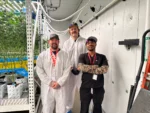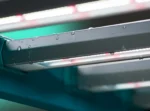BIOS, a company built by NASA scientists, takes a different approach to LED lighting. Instead of focusing solely on upfront cost, we emphasize long-term durability and performance—because in commercial cultivation, replacing cheap, unreliable fixtures is disruptive to your business.
Lighting is one of the most important investments in commercial cannabis cultivation, but with so many options on the market—ranging from high-performance, research-driven fixtures to bargain-bin imports—it’s easy to fall into the trap of price shopping.
The real question growers should be asking isn’t, How much do these lights cost?
But rather, How long will they actually last?
BIOS, a company built by NASA scientists, takes a different approach to LED lighting. Instead of focusing solely on upfront cost, we emphasize long-term durability and performance—because in commercial cultivation, replacing cheap, unreliable fixtures is disruptive to your business.

In this Q&A, Finn DeCaulp, Strategic Accounts Manager at BIOS, unpacks what true durability looks like in LED lighting, how low-quality fixtures create hidden costs through failures and downtime, and why the smartest growers think beyond the price tag to evaluate long-term return on investment.
From the science of LED degradation to the operational headaches of unreliable lighting, this conversation is packed with insights for growers serious about building a facility that performs for the long haul.
Q: Could you define “durability” in the context of LED lights and from the perspective of BIOS?
A: Durability as a general concept boils down to how much wear and tear, how much normal usage, how much application of the product in its intended state can something withstand before it starts to deteriorate to a point that is meaningful for the end user that has the product. Specifically, when that comes to LEDs, there are two facets that I think about: the physical durability of the machine itself and the relative performance of that photon delivery system–that LED light.
When you think about a product, you pull it fresh out of the box, it’s in peak condition. It’s going to be running at full capacity. It’s going to be what is advertised right on the spec sheet of the light. Now, with all lights, because of thermodynamics, any time that you have a machine and moving parts, they are gradually going to wear down and deteriorate over time. All LED lights have a degradation curve. You start out at 100% and then over time that 100% mark is going to start to curve down. There’s an inflection point where instead of it being a very gradual degradation and going from 100% to 99.9% to 99.85% to whatever, it starts going 97%, 95%, 90%, 83% and you have a steeper drop off over time. That is just the nature of machines.
All lights have this Achilles heel—degradation over time. The key consideration is how long a light maintains peak performance and how gradual its degradation curve is. This directly impacts the quality of the plants grown beneath it. For cannabis, this means both biomass yield—especially dry weight, which determines what you can actually sell—and the cannabinoid profile, including THC, CBD, and terpenes.
Q: How does this degradation curve specifically affect cannabis cultivators when it comes to managing different strains or cultivation styles?
A: While not every consumer cares about specific terpene profiles, there’s always a market for both mass-produced and craft-quality cannabis, much like the difference between mass-market beers and craft brews. To capture both audiences and build a strong market reputation, consistent quality matters.
When evaluating lighting, consider how long the light delivers peak output. The longer that peak lasts, the longer your garden operates at maximum efficiency. Once degradation accelerates, yields and product quality drop. At that point, you either accept lower-quality results or invest in supplemental lighting or full replacements—adding to your operational expenses (OPEX). While lighting is typically a capital expense (CAPEX), the long-term cost of ownership becomes a critical factor.
At BIOS, durability is rooted in the company’s NASA origins. The lights had to be reliable enough for the International Space Station, where shipping replacement parts isn’t an option. They were designed to last, with minimal degradation, maintaining peak performance for as long as possible. This approach led BIOS to offer a standout seven-year warranty on fixtures and a five-year warranty on power supplies—well beyond the industry standard of five years for lights and three for drivers.
With over a decade in the industry, BIOS has proven its ability to back these warranties. Their failure rates are impressively low compared to competitors, delivering both system longevity and consistent performance.
Q: Could you elaborate on the role of downtime that enters into the picture if your team finds itself needing to more abruptly replace lights? How could a hasty LED purchase lead to a lot more downtime than you need as a business?
A: Yeah, absolutely. So, you know, I’ve seen large facility operators and MSOs presented with solid lighting options from reputable brands. Yet, for reasons beyond me, some choose to buy containers of $30 LED lights from Alibaba, thinking light is light. The logic is that if the diodes and wattage are similar, it’s basically the same product—just cheaper. On the surface, that might seem reasonable, but it ignores the critical issue of downtime that inevitable comes with using a low-quality product.
When you fill a facility with cheap lights, you’re almost guaranteed to spend significant time replacing them—whether they fail completely, flicker, or lose sections of output.
Q: Can you walk us through what that downtime looks like in real-world cultivation operations? How does it disrupt daily workflows?
A: In a small setup, swapping a single light is manageable. But in a commercial grow spanning thousands of square feet, downtime becomes a major problem. Grow operations are dynamic environments with constant demands—managing water, nutrients, schedules, and more. When something unexpected happens, like a light failure, it disrupts the workflow, especially if you don’t have extra staff to handle it.
While lighting issues may not cause an immediate crop failure, they accumulate. A few dead lights might not seem catastrophic, but over time, they affect plant health, yield, and ultimately employee morale. Workers already putting in 10- to 12-hour days face added stress when equipment fails regularly, leading to burnout and disengagement. This impacts not just the product but the entire work environment, creating a ripple effect that harms productivity and quality.
In the long run, it’s always cheaper to pay for quality once than to replace inferior products multiple times. Focusing solely on upfront costs ignores hidden expenses like downtime, reduced product quality, and declining employee morale. Cutting corners on equipment reflects poorly on the business—it signals a lack of commitment to both the product and the people. As the cannabis industry matures, businesses that prioritize short-term savings over long-term reliability will struggle to maintain credibility, retain talent, and compete effectively.
Q: Are you guys seeing businesses out there dealing with Alibaba or Amazon more and more–or at least being hit with these ads for products more and more?
A: That’s a great question. I wouldn’t say it’s the first thing people mention when I talk to them, but it really depends on the type of product we’re discussing. For items like pots or buckets that are bought in bulk, there’s definitely a proliferation of cheaper options. When it comes to lighting, I’d imagine there’s been an increase as well, partly due to the digital era we live in—smartphones, AI, ad tracking, and personalized marketing. For some buyers, that works because they’re looking for common goods within certain tolerances, and saving $20 on a bundle makes sense if the quality is acceptable.
In terms of lighting, we’re seeing all kinds of new companies pop up. At MJ Biz last year, I was surprised by how many LED booths were there from brands I’d never heard of. They may have existed before but only recently started exhibiting, or they could be entirely new. At some point, the core designs for lights—like 4×4 rack lights—become industry standards. Instead of reinventing the wheel, companies tweak the designs slightly, maybe offering a 5×5 or 6×6 version.
Q: How do growers differentiate between companies that genuinely innovate versus those that just replicate without adding real value?
A: Aesthetic differences matter in industries like fashion, but in lighting, function is critical. I’ve bought cool-looking shoes from reputable brands that fell apart quickly because they prioritized style over durability. That’s a lesson that applies here: flashy doesn’t equal quality.
While there’s a flood of new LED brands advertising aggressively, the key question is longevity. Maybe they offer a five-year warranty—but have they even been around that long to honor it? What happens if you buy 3,000 lights and need to replace 200, 400, or even 600? Will they still be in business to support you in four or five years?
There will always be buyers looking for the cheapest option, from craft growers to MSOs focused on budget line items. That’s fine—not all products are for everyone. But if you want long-term success, it’s not just about the initial purchase. It’s about having a reliable partner for post-sale support, not just someone who sends a shipment and disappears. The real value comes from companies committed to their customers’ success, offering more than just products—they offer partnership.
The question isn’t just, “Can you survive through 2025?” It’s, “Are you setting yourself up to thrive in 2030 and beyond?” A trustworthy lighting partner will still be there, supporting your operations long after the sale is made.
Q: What are some helpful questions that a cultivation team can work through that might get them to identify the best lighting fit for them?
A: One thing that’s really important for growers—specifically decision-makers like the head grower—is understanding the goals of the owners. If the head grower is also an owner, all the better. But if not, it’s critical to understand where management is coming from. Are they supportive of making the best long-term decisions for the garden and the business, or do they have specific constraints that limit those decisions? Knowing this helps growers navigate lighting solutions effectively.
Sometimes the best option isn’t immediately accessible due to budget or other factors. That’s okay, but it’s important to recognize it as a goal.
Q: What strategies can growers use to balance budget constraints with the need for high-quality lighting?
A: Maybe you start with a second- or third-tier option, but you work toward the optimal solution by proving its value over time. If it’s never going to be a possibility, that’s something growers need to reflect on: Does this align with their values and professional goals?
Leaving that broader context aside, when evaluating lighting, growers should ask specific questions about durability—not just “What’s the warranty?” but also “What’s the failure rate?” Companies can be reluctant to discuss flaws, but transparency is key. At BIOS, we view these relationships as partnerships. Yes, we’re selling lights, but we’re also asking growers to trust us with their reputation, their daily operations, and their business viability. If something goes wrong, we’ll be there to make it right.
Growers shouldn’t just take that promise at face value. They should engage with vendors enough to feel confident that when they call for help, someone will answer. For example, one of our VPs recently got a call at 10 p.m. from a West Coast client with an urgent issue. Without hesitation, he booked a flight for the next morning, went straight to their facility, and helped troubleshoot the problem. That’s the level of support growers should expect.
Sure, when everything goes smoothly, you might get by with less support. But considering the time, money, and effort invested in a garden, why settle for anything less than a partner who’s fully committed to your success?



